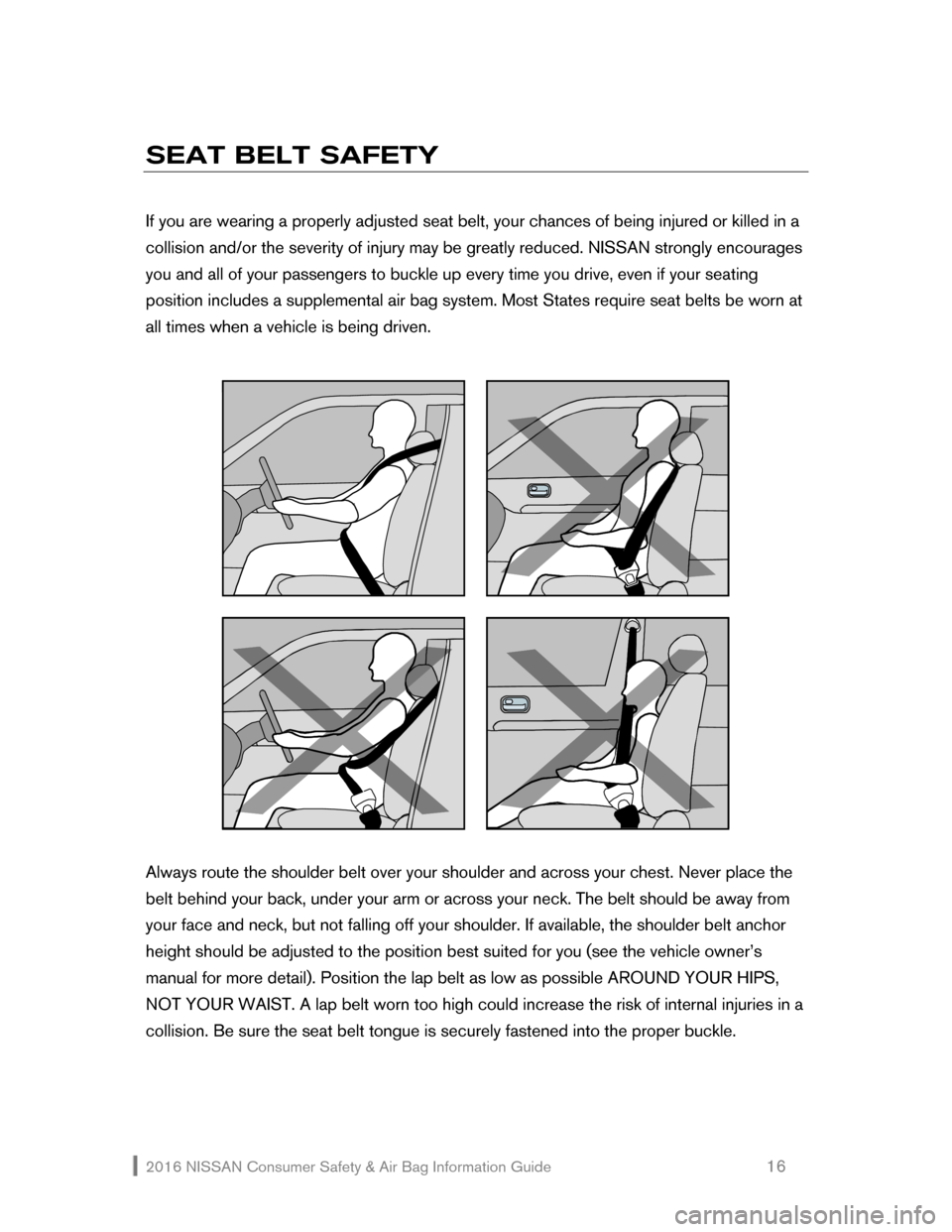ECU NISSAN SENTRA 2016 B17 / 7.G Consumer Safety Air Bag Information Guide
[x] Cancel search | Manufacturer: NISSAN, Model Year: 2016, Model line: SENTRA, Model: NISSAN SENTRA 2016 B17 / 7.GPages: 22, PDF Size: 1.2 MB
Page 14 of 22

OTHER SPE\fIFI\fS ABOUT SIDE-IMPA\fT, \fURTAIN SIDE-IMPA\fT,
AND \fURTAIN SIDE-IMPA\fT/ROLLOVER AIR BAG SYSTEMS
Do not allow anyone sitting in the front seat to extend his or her hand out the window or
lean against the door.
When sitting in the rear, do not hold onto the seatback s of the front seats , hang
anything from the head restraint or push or pull on the seatback pocket as this may
interfere with the proper operation of the air bag systems. Be especially careful with
children, who should always be properly seated and restrained in the rear seat .
Do not allow anyone to p lace their hand, leg or face near the side-impact air bag
modules on the side of the seatbacks of the front seats or near the curtain side-impact
air bag modules in the roof rails or in the front door panels
.
Curtain side -impact/rollover air bags are designed to infla te not only in rollovers, but
al so in near rollover situations. As a result, certain vehicle movements (for example,
during severe off-road driving) may cause these air bags to i nflate.
\fee the vehicle owner's manual for other important informa tion about side-impact,
curtain side -impact, and curtain side-impact/rollover air bag systems ( if the vehicle is
equipped with these systems) .
CHILD SAFETY
WHENEVER A \fHILD IS IN YOUR VEHI\fLE
The risk of serious or fatal injury to children i n automobile collisions can be reduced with a
properly installed child restraint. Before you install a child restraint in your vehicle, please
consult the vehicle owner’s manual and the child restraint manufacturer’s instructions for
proper installation.
Child restraints for infants must be used in a
rear-facing direction and therefore must never
be used in the front seat. An inflating front
passenger air bag could seriously injure or kill your
child. According to statistics, children are safer
when properly restrai ned in the rear seat than in the
front seat. NI\f\fAN and the federal government
recommend that children 12 and under should ride
in the rear seat, properly secured in child restraints,
booster seats, or seat belts, according to their size.
ipI\b 1n\f\fW1 RSNmulDA \fYVDLM - WHA TYO nNVSAlYLHSN cuHED IP
Page 15 of 22

If you must install a forward-facing child restraint in the front passenger seat, move the
passenger seat to the rearmost position. \fee the vehicle owner’s manual for details and
additional important information.
\fHILD RESTRAINTS FOR INFANTS AND SMALL \fHILDREN
nNVYNLm YNE mlYFF KGHFEADN mGSuFE YFgYMm ,D oFYKDE HN YN YooASoAHYLD KGHFE ADmLAYHNL gGHFD
AHEHNO HN LGD sDGHKFDr 3YHFuAD LS oASoDAFM umD Y KGHFE ADmLAYHNL KYN ADmuFL HN mDAHSum HNwuAM SA
EDYLGr
Children and infants should never be carried on
your lap. It is not p ossible for even the strongest
adult to resist the forces of a severe collision . The
child could be crushed between the adult and parts
of the vehicle. Also,
never put the same seat belt
around both your child and yourself, or another
child.
Always insta ll the child restraint properly, and check that it is securely held in place by the
vehicle’s seat belt or LATCH system (if so equipped) . An improperly installed child restraint
could lead to serious injury or death in a collision. \fee the vehicle owner’s manual and your
child restraint manufacturer’s instructions for complete details.
Child restraints specially designed for infants and small children are offered by several
manufacturers. When selecting any child restraint, keep the following points in min d:
1. The LATCH system (Lower Anchors and Tethers for CHildren) is a universal child
restraint system. This system – which may also be referred to as the I\fOFIX or I\fOFIX
compatible system – allows the child restraint to be installed into the vehicle without
the use of seat belts. Both the vehicle and child restraint must have LATCH s ystem
capabilities.
2. Choose only a restraint with a label certifying that it complies with Federal Motor
Vehicle \fafety \ftandard 213.
3. Always make sure the child restraint is app ropriate for the age and size of your infant or
small child. Remember that as your child grows you will need to replace the child
restraint.
201\b NI\f\fAN Consumer \fafety & Air Bag Information Guide 14
Page 17 of 22

SEAT BELT SAFETY
If you are wearing a properly adjust ed seat belt, your chances of being injured or killed in a
collision and/or the severity of injury may be greatly reduced. NI\f\fAN strongly encourages
you and all of your passengers to buckle up every time you drive, even if your seating
position includes a supplemental air bag system. Most \ftates require seat belts be worn at
all times when a vehicle is being driven.
Always route the shoulder belt over your shoulder and across your chest. Never place the
belt behind your back, under your arm or across your neck. The belt should be away from
your face and neck, but not falling off your shoulder. If available, the shoulder belt anchor
height should be adjusted to the position best suited for you (see the vehicle owner ’s
manual for more detail). Position the lap belt as low as p ossible AROUND YOUR HIP\f,
NOT YOUR WAI\fT. A lap belt worn too high could increase the risk of internal injuries in a
collision. Be sure the seat belt tongue is securely fastened into the proper buckle.
201\b NI\f\fAN Consumer \fafety & Air Bag Information Guide 1\b